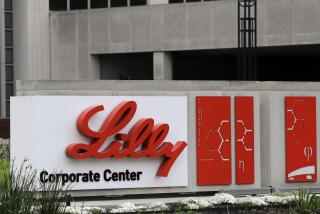Generic Drugs Find Growing Acceptance : Health care: Sales of brand-name medications have dropped by one-third over the last decade.
- Share via
Maxicare Health Plans’ doctors are urged to prescribe generic drugs when possible. The result: About 40% of all prescriptions are now filled by generics--a $5-million savings last year in the HMO’s drug purchasing budget.
San Diego allergist Dr. Eli Meltzer used to prescribe a brand-name drug called Theodor only for his asthma patients. But recently, he has been comfortable recommending a generic version of the medication for unclogging bronchial tubes. His patients save $12 a prescription.
Such growing acceptance by doctors combined with cost pressures on health care plans, such as HMOs, have catapulted generic drugs from about 5% of all
U.S. prescriptions 10 years ago to close to 40% today, according to drug analyst Hemant Shah of the HKS & Co. investment firm in Warren, N.Y.
Although dollar sales of generics have not grown as fast (because of the wide differences in price), the growing importance of generics in the U.S. health care system was demonstrated this week when Kansas City-based Marion Merrell Dow Pharmaceuticals--a maker of brand-name prescription drugs--announced that it is buying Rugby-Darby Group Cos., the nation’s leading seller of generic drugs.
In April, Merck & Co., the world’s largest pharmaceuticals manufacturer, announced that it would soon begin selling 10 discount-priced drugs via a generic drug subsidiary called West Point Pharma. Last year, Ciba-Geigy and Upjohn announced that they would begin marketing generic versions of certain brand-name drugs.
Marion Merrell Dow’s decision was fueled in part by the fact that one of its major products, Seldane, the nation’s leading anti-allergy drug, will lose its patent protection in 1994. Once the patent expires, the drug will be available for the generic market.
Moreover, the company last year lost its exclusive patent on Cardizem--a drug to treat high blood pressure and angina--which generated 32% of the company’s 1992 sales. And no new blockbuster drugs are on the horizon to compensate for those patent losses, said Jack Lamberton, a drug industry analyst with NatWest Securities in New York City.
Generic drugs may differ somewhat from the brand-name versions, but they must receive “bio-equivalent” certification from the U.S. Food and Drug Administration before they can be marketed.
Because manufacturers spend a minimum on marketing and research, the drugs on average sell for half the price charged by former patent holders.
The cost differences have attracted increasing attention as health providers and the people who pay the bills come under growing pressure to cut cost whenever possible.
Although health maintenance organizations say they leave it to the doctors to decide which particular drugs are acceptable for a given diagnosis, they make a point to keep doctors informed through hospital-pharmacy and therapeutic standards committees when generic versions of brand-name drugs become available.
“If it’s an appropriate therapeutic substitute, we are going to support generics. We are moving in that direction to try to control costs,” said Mary Pat Yatsko, senior vice president of health servicesfor Health Net, based in Woodland Hills. It is California’s second-largest health maintenance organization with 930,000 members.
“Everyone wins out--the patient, the patient’s employer group and the HMO--if we can control our costs,” said Warren D. Foon, vice president of operations at Maxicare, the Los Angeles-based health maintenance organization with 300,000 members.
Meltzer and other doctors insist that drug quality and not cost is the most important consideration in prescribing drugs. But they said generics have become more accepted in the medical community as clinical evidence demonstrates that many are safe and effective.
“We are using generics more if, in fact, we know that they are as safe, as effective and cheaper than the brand name,” Meltzer said. “But I want to make sure the first two criteria are met before I consider the cost factor.”
The trend toward greater use of generics is likely to accelerate under any health care reform package approved by Congress, according to many health care analysts, Some major drug firms, however, including Pfizer and Johnson & Johnson, say that for the time being they have no plans to sell generic drugs. They cite the bigger profits available by developing proprietary drugs and the “culture clash” inherent in trying to sell both premium brands and commodity products.
Both companies also said they fear that a generic drugs operation would cause some customers to perceive a “two-tiered” pricing system that might favor some buyers over others.
Generic Drug Sales
Generic drug sales have been growing faster in recent years than sales of brand name drugs, accounting for an estimated 20% of the $41.9-billion U.S. drug market last year.
More to Read
Inside the business of entertainment
The Wide Shot brings you news, analysis and insights on everything from streaming wars to production — and what it all means for the future.
You may occasionally receive promotional content from the Los Angeles Times.










